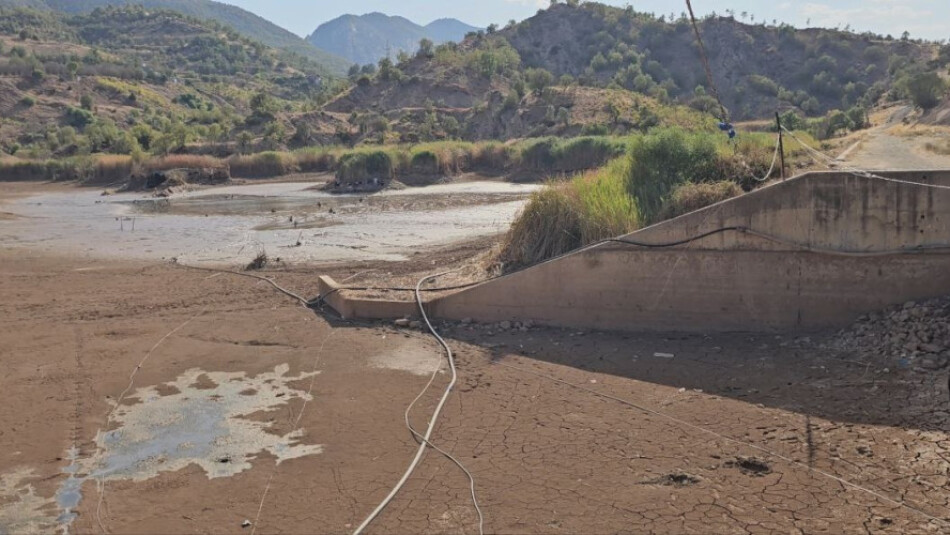
For more than three decades, the Bibava Dam in the Sarsang sub-district of Amedi district brought water, agriculture, and prosperity to surrounding villages. Today, it has turned into a cracked wasteland, the result of unprecedented drought and climate change that have devastated large parts of Duhok.
"I witnessed the death of thousands of fish and the loss of hundreds of acres of farmland when the dam dried up," farmer Amed Issa told Peregraf. "Since September, it has become like a desert." He alone lost 250 dunams of orchards and vineyards.
According to Peregraf’s follow-up, the dam—built in 1990—has never completely dried up until now. Current images show an arid, desert-like basin where water once supplied farming, fishing, and livelihoods.
Desertification Spreads
The United Nations has long warned that Iraq, including the Kurdistan Region, is among the world’s most vulnerable areas to drought and climate change, ranking fifth globally. Desertification, shrinking water reserves, and falling harvests are now evident across Duhok.
Peregraf’s investigation found that dozens of agricultural ponds have also dried up this year, hitting farmers and villagers the hardest. For the first time, many in Amedi district resorted to using tankers to keep their grape crops alive.
Amed believes mismanagement also played a role. "The dam needed dredging because of soil accumulation, and too many large water pumps were installed around it," he told Peregraf, urging government intervention.
Wells, Rivers, and Shrinking Ponds
In addition to rainfall and dams, the Kurdistan Region depends on major rivers—the Great Zab, Little Zab, and Sirwan—along with thousands of springs and wells. But these too are under strain.
Duhok province alone has more than 4,500 wells. A 2022 report by the Statistics Board recorded over 2,000 for drinking water and nearly 2,300 for agriculture. Of more than 3,000 natural springs, nearly half have dried up.
"Seventy percent of rainfed agriculture has been damaged," Muslih Hassan, Deputy Director General of Agriculture in Duhok, told Peregraf. "This year’s wheat and barley harvest has been poor."
The Kurdistan Regional Government (KRG) has built 60 agricultural ponds and several dams across Duhok, including Duhok, Khans, Sbins 2, Gali Bandawa, Biduhé, and Kashkan. Yet low rainfall has left them depleted. Duhok Dam, for example, has a capacity of 52 million cubic meters but currently holds less than 20 million.
Water Levels in Freefall
"The water situation in Duhok is bad due to low rainfall," Hêzha Abdulwahid, Director of Water Resources in Duhok, told Peregraf. She confirmed that groundwater and surface water levels are both declining, with well levels in some areas dropping by up to 36 meters.
The regional government has allocated funds this year to mitigate drought’s effects, but officials admit the crisis is part of a larger global challenge. "Climate change affects the entire world, not just the Kurdistan Region," Hassan told Peregraf. "We have plans to assist farmers and clean water channels."
There are currently 21 dams across the Kurdistan Region, three of them large—Dukan, Darbandikhan, and Duhok—with a combined storage of about 10 billion cubic meters of water. International standards suggest the region requires 12 billion cubic meters annually.
A Serious Threat Ahead
Meteorology expert Matîn Saeed told Peregraf that groundwater has dropped alarmingly—by 50 meters in some areas near Mosul Dam, and by 70% across Iraq as a whole. "This is a very serious threat," he said.
Although forecasts suggest a stronger rainy season ahead, Saeed is not hopeful. "Even if rainfall is first-class, it will not compensate for this year’s water scarcity," he told Peregraf.
Experts also point to poor water management. A previous Peregraf investigation concluded that failure to enforce conservation policies and upgrade distribution systems has worsened the crisis. Without urgent action, water security in the Kurdistan Region faces an uncertain future.